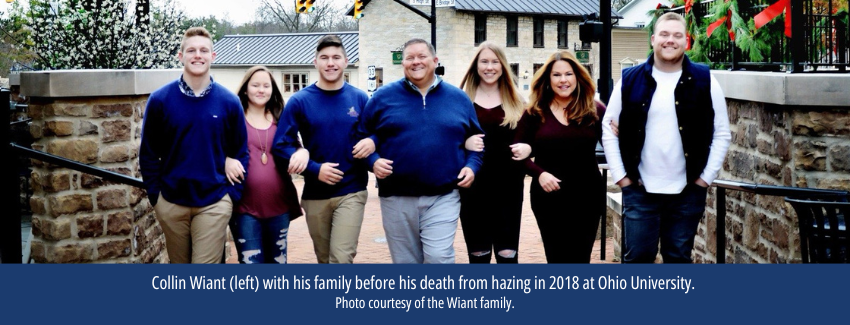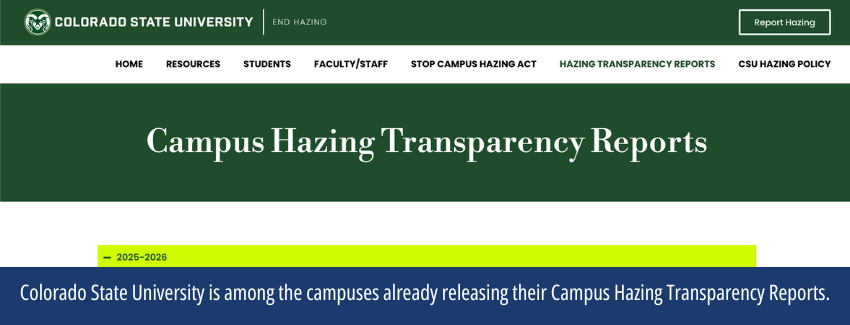147 hazing incidents since 2018: The state of hazing in Ohio
One-third of Ohio colleges are not publicly reporting hazing incidents as required by state law, according to a HazingInfo investigation

Editor’s note: This is part of our blog series, “The State of Hazing,” investigating the impact of hazing laws in nine states that require public disclosure of hazing incidents.
Across Ohio’s 68 colleges and universities, there were 147 reported incidents of hazing since 2018, according to a new HazingInfo.org investigation.
But that’s not the full picture of hazing in Ohio.
Twenty-two of those higher education institutions are not providing any information about hazing incidents on their websites, despite a state law requiring public disclosure. And experts say even schools that are disclosing hazing incidents are likely under-reporting.
That leaves students and families to guess about the extent of hazing on their campuses.
“147 can’t possibly be the real number,” said former state Senator Stephanie Kunze. She sponsored Collin’s Law, the state’s anti-hazing law passed in 2021.
She pointed to Miami University with 10 reported hazing incidents from 2018 to early 2025, a number she said seems too low. The school has more than 18,000 students and a campus social scene that revolves around Greek life, with about one-third of students in a fraternity or sorority.
“We wanted Ohio to be a leader in hazing prevention,” she said. “We need to be sure we are holding our administrators accountable, making sure the data is accurate and that we have it on the school websites.”
‘Boys don’t like to be told what to do’
 One of those reports from Miami University involves Tyler Perino, a student who was paddled so hard by members at Delta Tau Delta fraternity in 2019 that he was hospitalized.
One of those reports from Miami University involves Tyler Perino, a student who was paddled so hard by members at Delta Tau Delta fraternity in 2019 that he was hospitalized.
“My son took a risk, reported it, and has tried to create change” by speaking out about hazing across the state, said Laura Perino, Tyler’s mother, who has also spoken publicly about the hazing Tyler endured.
“When you are physically abused, assaulted, made to drink … he carries the pain of that trauma with him,” Laura Perino said.
She once asked one of Miami University’s leaders about requiring an adult to be present in each fraternity to help monitor its activities. “He said, ‘We found that boys don’t like to be told what to do.’ It didn’t sit well with me.”
Last week, Miami University suspended a different fraternity, Kappa Alpha Psi, for 15 years over allegations of hazing that included beating and paddling new members.
The same fraternity reportedly also faced hazing allegations in 2019 and 2022.
25 Ohio colleges report at least one hazing incident
Ohio is currently one of nine US states with laws or policies requiring campuses to post their hazing incidents online.
Ohio college hazing data, 2018 to February 2025

Across those nine states, the HazingInfo.org investigation found 946 reported incidents of hazing on 171 campuses between 2018 and February 2025. It is the first time the total number of reported US hazing incidents has been tallied.
In Ohio, the 147 reported hazing incidents were concentrated on 25 campuses. The Ohio State University, the state’s largest, also had the greatest number of hazing incidents, with 41 cases reported.
The HazingInfo investigation only included misconduct that each institution formally determined to be hazing. It omitted other kinds of misconduct like alcohol violations or assaults that weren’t officially labeled as hazing.
All but three of Ohio’s 68 institutions have a hazing policy, as required by Collin’s Law, while 54 campuses provide an online reporting form for students and others to report hazing.
Ohio has recorded at least 14 hazing deaths dating back to 1899.
Collin’s Law seeks to hold colleges accountable
 Collin’s Law is named after Collin Wiant, an 18-year-old freshman at Ohio University who died in 2018 following hazing at Sigma Pi fraternity.
Collin’s Law is named after Collin Wiant, an 18-year-old freshman at Ohio University who died in 2018 following hazing at Sigma Pi fraternity.
The law requires every Ohio institution of higher education to publicly post a report with all violations of its hazing policy, updated twice a year and maintained on its website for five years.
Collin’s mother, Kathleen Wiant, called Ohio's hazing incident numbers “really disheartening. They’re just getting away with it.”
She is particularly concerned that 32% of Ohio colleges aren’t providing any information about campus hazing incidents.
“We’re not going to see significant change until universities are held accountable,” said Wiant, who worked closely with Kunze to drive the passage of Collin’s Law.
Wiant and her family started the Collin Wiant Foundation in her son’s memory, and she has shared Collin’s story at colleges across the country as an anti-hazing advocate.
She believes too many universities are quick to shift blame for hazing to the individual students involved, rather than taking responsibility for their campus climate and culture.
“As long as they have a policy on paper, they think they’ve done their part,” Wiant said. “It’s so upsetting to think this just keeps going on, no matter what the consequences are.”
Reaching younger students to prevent hazing
 Shari Foltz of Sunbury, Ohio, has also worked to broaden awareness about hazing in Ohio and beyond since the death of her son, Stone, from hazing at Bowling Green State University in 2021.
Shari Foltz of Sunbury, Ohio, has also worked to broaden awareness about hazing in Ohio and beyond since the death of her son, Stone, from hazing at Bowling Green State University in 2021.
She founded the iamstonefoltz Foundation in his memory and has focused on providing hazing prevention education to students and parents, particularly in high schools.
“If Stone had any type of education on hazing, he would still be here,” Shari Foltz said. She and her husband, Cory, are working with lawmakers to get hazing education included in every Ohio high school’s required 9th grade health classes.
She has heard from students across the state who have asked her to come to their campuses to share Stone’s story “because of all the hazing going on.”
“We find students worry about retaliation. They don’t want to report because they’re scared,” Foltz said. “It’s heartbreaking and terrifying.”
How well are Ohio universities following the law?
 While Collin’s Law is a step forward in preventing hazing, state laws that require transparency about hazing incidents “rely on universities and colleges to do appropriate investigations. I can tell you, that doesn’t always happen,” said attorney Sean Alto.
While Collin’s Law is a step forward in preventing hazing, state laws that require transparency about hazing incidents “rely on universities and colleges to do appropriate investigations. I can tell you, that doesn’t always happen,” said attorney Sean Alto.
He represents both the Wiant and Foltz families in lawsuits they brought against the universities and fraternities following the deaths of their sons.
“I’d like to see universities take more responsibility for what’s happening on their campuses, and not just: ‘We had a training,’” he said. “Hazing is going to continue, period, unless they take a much more aggressive approach.”
Alto is currently representing a student at the University of Toledo who reported being hazed. The school currently reports zero incidents of hazing since 2019.
“I don’t believe it,” Alto said. “There’s no doubt this (case) is hazing. I’ll be watching to see how it’s investigated.” He said schools sometimes label such incidents as “underage drinking” or other offenses instead so that it doesn’t have to be included in their hazing transparency report.
State-led approach creates more buy-in among colleges
Ohio’s Department of Higher Education is more actively involved in overseeing the implementation of Collin’s Law than many of their peer agencies in the eight other states with transparency laws.
Collin’s Law required the state Chancellor to develop a statewide hazing prevention plan for all Ohio colleges and universities, created through a working group that involved campuses across the state.
 That centralized effort led to a model anti-hazing policy for schools, reporting procedures, an annual anti-hazing summit, and other resources, said Will Cangialosi, formerly assistant director of chapter services at Ohio State until January. He is currently director of fraternity and sorority life at Carnegie Mellon University.
That centralized effort led to a model anti-hazing policy for schools, reporting procedures, an annual anti-hazing summit, and other resources, said Will Cangialosi, formerly assistant director of chapter services at Ohio State until January. He is currently director of fraternity and sorority life at Carnegie Mellon University.
The state-led approach may also help explain Ohio’s relatively high rate of compliance with the transparency requirements of Collin’s Law, with 68% of institutions posting a campus hazing transparency report as required. That ranks second behind Pennsylvania across the nine states.
The state’s involvement also helped create broad buy-in from the state’s higher education institutions, Cangialosi said. “It gave us the leg up … and helped in having larger campus-wide conversations” about hazing prevention.
Ohio State will host the state’s fourth annual Anti-Hazing Summit on Aug. 7, 2025.
Coming soon: A new era of hazing reporting
A new federal anti-hazing law will require all US colleges and universities to publish hazing transparency reports on their websites by December.
And that will launch a new era of hazing reporting that will bring more consistency and clarity to the way hazing is reported, Cangialosi predicted.
That’s an issue many campuses have wrestled with as they try to figure out who is responsible for creating and implementing state-mandated hazing policies and reporting requirements, he said.
The new federal law will require schools to disclose the total number of hazing incidents reported to the school or local police — not just those that result in formal findings of hazing by campus authorities.
The work of tracking and reporting hazing incidents will fall to trained campus professionals who already report other campus crimes, such as robberies and sexual assaults.
“We’re going to see an uptick in reporting,” Cangialosi said. “It’s not going to tell us that more hazing is happening. It will tell us the educational gaps are closing, and people are recognizing hazing and reporting it as such.”

Learn about hazing on your campus: HazingInfo's Campus Lookup
Read more in our series about the State of Hazing in Georgia, Louisiana, New Jersey, Pennsylvania, South Carolina, Virginia, and Washington.




